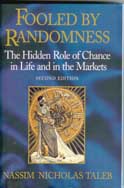
Fooled by Randomness
Fooled by Randomness
I recently received a book from my longtime friend Ray, with whom I constantly have discussions on poker, bridge, health, and life. “You will really enjoy this book; it’s right up your Bob Ciaffone is one of America’s best-known poker players, writers, and teachers. He has numerous poker tournament wins and placings, the most prominent being third place in the 1987 World Championship. He has been a poker teacher since 1995, with his students having earned well over a million dollars in tournament play. Bob's website is www.pokercoach.us alley,” he said. The book was Fooled by Randomness, subtitled The Hidden Role of Chance in the Markets and in Life. As usual, Ray was right. The book was written by a stock market trader, Nassim Nicholas Taleb, but he took ideas about mathematical randomness and gave them a sweepingly wide application to all walks of life. Even though poker was omitted from the author’s discussion, it was no doubt the result of his ignorance on the subject rather than any lack of pertinence. I am going to take some of his ideas and show how they fit poker in a highly suitable manner.
Bob Ciaffone is one of America’s best-known poker players, writers, and teachers. He has numerous poker tournament wins and placings, the most prominent being third place in the 1987 World Championship. He has been a poker teacher since 1995, with his students having earned well over a million dollars in tournament play. Bob's website is www.pokercoach.us alley,” he said. The book was Fooled by Randomness, subtitled The Hidden Role of Chance in the Markets and in Life. As usual, Ray was right. The book was written by a stock market trader, Nassim Nicholas Taleb, but he took ideas about mathematical randomness and gave them a sweepingly wide application to all walks of life. Even though poker was omitted from the author’s discussion, it was no doubt the result of his ignorance on the subject rather than any lack of pertinence. I am going to take some of his ideas and show how they fit poker in a highly suitable manner.
There is an irregularity in random events that many people fail to appreciate. Random means just that, and a random event that occurs on an average of one out of 10 occasions (to use an example) will have some amazing streaks if applied over a long period of time. One would be surprised if those streaks did not include it occurring twice in a row, or being absent 40 consecutive times. Who in their long hold’em poker career has not picked up pocket aces back-to-back, or gone for a hundred deals in a row without a pocket pair or a big-kicker ace?
Despite the extremes of luck distribution that may occur, players often commit fallacies when dealing with these streaks. For example, a player who is running bad may start to take extraordinary measures in order to regain the feeling of being able to win a pot. He steams by playing more starting hands, taking punishment in the flop betting just to stay in contention, and then tries a ridiculous bluff when all else fails. But mathematically speaking, there is no way to ascertain when a streak of bad luck will end. Lots of players seem to think that a streak lasts for precisely one session. Yet, many a losing streak lasts for only a portion of a session — or continues without interruption the next time the player sits down. I am not saying a player should always hang in there and weather the storm, because some people perform poorly enough during such a streak to have their result expectancy go from positive to negative. But to quit just because of fear that an unlucky cloud will follow you for precisely a whole session — no more, no less — is flawed thinking that shows your inability to grasp the nature of random events.
The lucky poker player — temporarily lucky — also may behave in a manner that shows a lack of understanding the distribution of randomness. He may believe that when the lucky star is overhead, the nature of his hand should be disregarded in an effort to “push his luck to the hilt.” The problem arises in judging where the hilt is located. When “the cabbages are eating the rabbits” (a favorite expression of my friend Blacky Blackburn), it is only a matter of time before the normal state of affairs of the better hands defeating the worse ones returns. If the fellow with the lucky star believes the force will be with him for a full session, he is most probably going to give his winnings back with interest.
Another error discussed in the book is aiming for a big plus in positive outcomes without paying sufficient attention to the essence of the situation, which is the net plus. Winning eight out of 10 times does not guarantee a net profit, because we must consider the amounts won and lost. Here is an interesting story related to me by the late Bill Smith, the 1985 world poker champion. A fellow nicknamed “Pinky” once made the bet in a no-limit hold’em game that he would win each pot, and he laid 6-to-5, to boot! Pinky won more pots than he lost, showing a large plus on his bet, even though every player in the game was aware of the wager. Even so, he did not have a winning session. I guess he was “a little unlucky” to win all of those pots and still bust out.
Author Taleb is especially castigating of stock traders who do not take out sufficient protection against an unexpected catastrophic downturn. One memorable fellow in the book made his company a quarter-billion dollars over a six-year period, then lost $600 million in one week. Color him busted and unemployed. His poker counterpart is the no-limit hold’em player who likes to check his sets. He often wins an extra bet this way — until someone picks off an inside straight with the free card and relieves the checker of his entire stack.
Taleb presents a quiz question of another author on randomness, Deborah Bennett, involving a parlay, that was given to doctors. Try this question yourself: “A test of a disease yields a rate of 5 percent false positives. The disease strikes one-one thousandth of the population. People are tested at random, regardless of whether they are suspected of having the disease. A test subject returns a positive diagnosis. What is the probability of the subject having the disease?”
Most of the doctors taking the test answered 95 percent. This wrong answer ignores the info about the disease striking only one person out of a thousand. The correct answer is only 2 percent! Fifty people tested positive on the average (5 percent of the 1,000 base tested), but only one of these had the disease. You must consider what the base of the data was when judging the likelihood of a particular situation existing. Poker errors of this nature would be your failing to pay attention to the number of people dealt in at the start of a hand, or who stayed for the flop, when trying to ascertain whether the bettor has you beat. The wider the base of the mountain, the higher the peak is likely to be.
Here is a phenomenon I have seen many times: The early leader in a tournament has amassed an impressive number of chips. Is he a strong player? In these days of big fields, there are many more weak players than strong ones, so there is a good chance that a front-runner has simply been lucky.
Another factor at work here is that bad players usually play more hands. (For example, good players are more than willing to “pot out” with bad ones, when that ethical breach is allowed, because the bad players usually win more pots than the good ones.) The more at-bats, the more hits; a worse hitter may well out-hit a better one who does not see as much action, even though the former has a lower batting average.
Also, you have a greater possibility of playing some big pots if you are willing to take the worst of it in hand matchups. Your opponents are more likely to gamble with you when they figure to have the best of it. If enough loose players are getting their money in for a series of several large pots in which they are on the average perhaps a 3-to-2 underdog, a small number of them will amass a fortune by continuing to double up even though they are going sharply uphill.
Considering the base also explains why there are so many relatively unknown players at the last few tables of the World Series of Poker championship these days. I used to know 90 percent of the starting field personally. Now, that figure is probably less than 10 percent.
Even though there is a lot more to poker than mathematics, do not fall into the trap of thinking the only math applicable to poker is the odds on making your hand. As you can see, many probability concepts need to be understood properly to be a well-rounded poker player.

